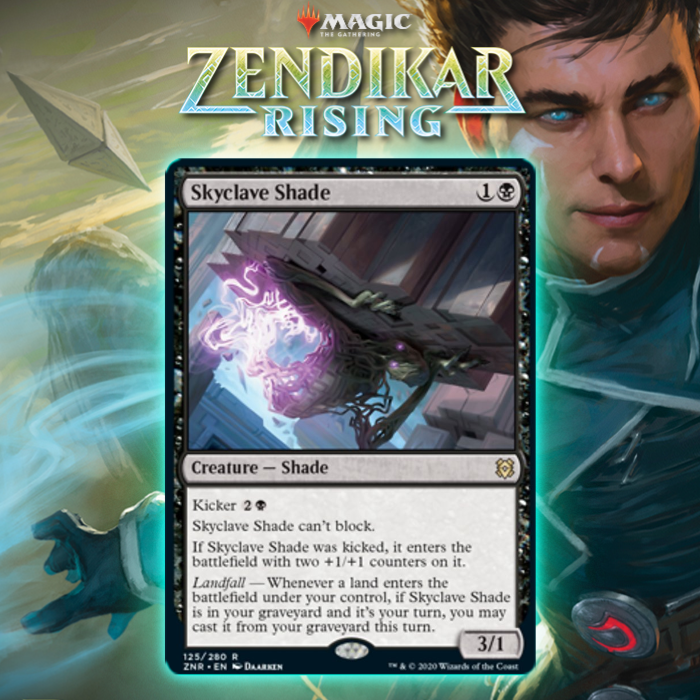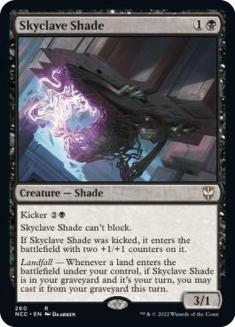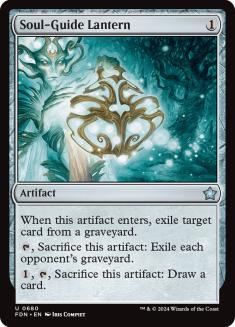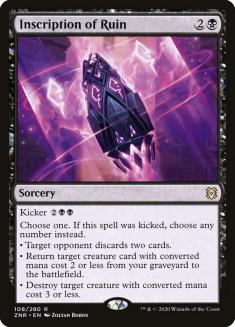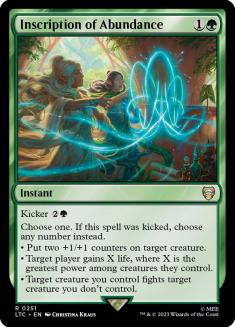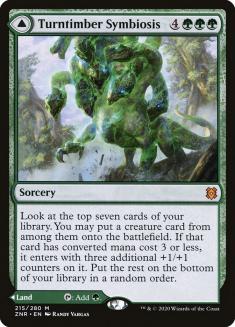Don’t you love it when a set delivers exactly what you’ve been hoping for?
Skyclave Shade isn’t the type of card I usually write about during preview season. I’m typically on the lookout for cards that offer something unique to the format or are extreme power outliers. Skyclave Shade is, at its core, a pretty simple Magic card. It’s just participating in combat, and even then, it’s only going in one direction. There’s very little chance that a card that influences the game along such a narrow axis can ever cross the line into overpowered territory.
Fortunately, despite what Magic Twitter would have you believe, there is a lot of space for Magic cards to occupy between broken and unplayable. Sometimes a card derives its impact from meaningfully filling an under-served spot on the curve. Black decks have been missing a reasonable aggressive two-drop for a while now, and Zendikar Rising is delivering several of them into our greedy mitts. Real two-mana threats unlock multiple deckbuilding paths for black and Skyclave Shade is the one that has inspired me the most so far.
There are some strong hints regarding the strength of this card. First off, Skyclave Shade has a lot of words in its text box. Yes, I understand how stupid this sounds. No, I don’t think that makes it any less true. The “word salad” mode of threat creation that we’ve seen prominently displayed on cards like Questing Beast seems to be an effort to subsidize cards that must prop up a substantial portion of the metagame. They are meant to be the breadcrumbs that lead us to a balanced format with aggro, midrange, and control decks all finding appropriate representation. Does Skyclave Shade really need to have kicker and scale into the late-game? I don’t think so, but the fact that it does should virtually guarantee that it gets to be the face of black aggressive decks.
Skyclave Shade’s creature typing is another text-box-based hint of just how powerful this card might be. “Creature – Shade” strikes me as purposefully irrelevant. Give this thing any meaningful creature type and you’re probably pushing a tribe into the realm of the unfair and locking out a bunch of other options. I’m happy this ended up a Shade, because it allows us to consider far more archetypes in good faith.
Of course, it’s hard to make it through preview season without getting bogged down in the mire of historical comparison. I don’t usually find it useful to go down this path, but Scrapheap Scrounger was a format-defining card in an enormously powerful era of Magic. It’s proof-of-concept that a recursive three-power threat can keep pace with the best Magic has to offer. In Pioneer, I expect Skyclave Shade to quickly carve out a role in Mono-Black Aggro alongside Scrapheap Scrounger. In Historic, it’s going to carry the archetype on its own.
Today though, I’m happily turning my focus towards Zendikar Rising Standard for the first time in a while. Let’s start with a look at our Mono-Black options.
Creatures (23)
- 3 Rankle, Master of Pranks
- 2 Tymaret, Chosen from Death
- 3 Hunted Nightmare
- 3 Serrated Scorpion
- 4 Whisper Squad
- 4 Skyclave Shade
- 4 Nullpriest of Oblivion
Lands (24)
Spells (13)

The biggest beneficiary of the new two-drops is Demonic Embrace. Between Nullpriest of Oblivion and Skyclave Shade, you’re now looking at either a six-power flyer or a doubly evasive five-power lifelinker on Turn 3. Previously, Demonic Embrace had to settle for suiting up a one-drop or Kitesail Freebooter, or else patiently waiting around for Rotting Regisaur to come online. The beats are coming faster now, and you’re going to feel the difference. Nullpriest of Oblivion really deserves its own article. It’s every bit as impactful as Skyclave Shade, if not more so. And while Tymaret, Chosen From Death doesn’t quite keep pace with the rest of the squad, it remains an important tool in an Uro, Titan of Nature’s Wrath-based world.
Despite substantial gains in the two-mana slot, we’re now low on playable one-mana options, and neither Serrated Scorpion nor Whisper Squad is exactly what we were looking for here. Once we’ve conceded and put them in our deck though, Village Rites starts to feel like a must. We’re just powering to our absurdly powerful recursive cards, and we don’t really mind burning through our fodder if we’re eventually coming across Demonic Embrace and Skyclave Shade. Village Rites is the first time we’re taking advantage of Skyclave Shade as sacrifice fodder, but it certainly won’t be the last. We have the chance at hitting with the ultimate Rankle, Master of Pranks here, where we discard a Skyclave Shade and sacrifice a Shade already on the battlefield to kill an opposing creature and then happily play a postcombat land to return both Shades to the battlefield.
This deck is a conservative example of the type of shenanigans that I think you can get up to with the modal double-faced cards (DFCs) in this set. We’re mostly playing Agadeem’s Awakening and Hagra Mauling because we can afford a tapped land, and Awakening has the potential to occasionally be a game breaker in our creature-rich deck. Without any effort to maximize the card it will steal games, and it comes with the added benefit of letting us happily cheat to 27 lands in our aggressive deck. If you don’t think this is an earth-shattering change to the way we play games of Magic in lower-power environments, I don’t really know what I can say to convince you. It just seems obvious to me, and I expect numbers on these lands to float higher and higher as the format goes on.
We round out the deck with what I expect to be the best removal spell in Standard, Bloodchief’s Thirst. The versatility and mana efficiency will make it the go-to option in any deck that is mostly willing to play at sorcery speed. Obviously, this will create some vulnerability to things like Embercleave, but this can be addressed in the sideboard. In Game 1, I’ll take the ruthlessly efficient option.
Creatures (19)
Lands (24)
Spells (17)
- 2 Soul-Guide Lantern
- 3 Agonizing Remorse
- 1 Call of the Death-Dweller
- 4 Village Rites
- 3 Bloodchief's Thirst
- 1 Inscription of Ruin
- 3 Agadeem's Awakening
Sideboard

Here’s a look at an attempt to maximize the absurd Agadeem’s Awakening in both effect and as a worthwhile modification to a manabase. It’d be shocking to see a Lurrus of the Dream-Den deck like this running 26 lands, but if lands 24-26 are also the best spell in your deck, it becomes a trivial cost.
Having played a lot of Archfiend’s Vessel / Lurrus endgames in Historic, I’m used to having to play very slowly and defensively with my Lurrus. Once Agadeem’s Awakening and Nullpriest of Oblivion become part of your plan, you can burn your Lurrus with reckless abandon. Don’t forget you can kick both Skyclave Shade and Nullpriest of Oblivion when you’re casting them with Lurrus’s aid. This deck has so many rebuilds now and Acquisitions Expert being able to put together a party of two is going to take a good card from your opponents more times than you would expect.
Soul-Guide Lantern is an easy inclusion here. You need real plans in your maindeck against Uro, and Lantern is the best one to combine with Lurrus. This is also my first attempt at playing Inscription of Ruin, and I won’t be shocked to find out I want more copies. It might just be better than Call of the Death-Dweller.
Skyclave Shade feels slightly off-theme here, but it’s all in the name of finding footing in games through aggression. All of the disruption and resiliency in the world is meaningless without a clock. Shade allows you to make aggressive starts and to play the long game, making this deck closer to classic midrange like Jund than what we’ve seen over the past year.
Here’s another deck that attempts to use Skyclave Shade to bring the gap between plans.
Creatures (25)
- 1 Massacre Wurm
- 4 Gray Merchant of Asphodel
- 1 Murderous Rider
- 3 Ayara, First of Locthwain
- 2 Tymaret, Chosen from Death
- 2 Nightmare Shepherd
- 4 Acquisitions Expert
- 4 Nighthawk Scavenger
- 2 Skyclave Shade
- 2 Nullpriest of Oblivion
Lands (24)
Spells (11)

I think this deck is an awesome illustration of what is possible on the back of the modal DFCs. Malakir Rebirth has blowout potential alongside a lot of the pieces here, but playing it on its face would be a fool’s errand. However, using it as part of a package that allows you to cheat to 30 lands into a deck that can never miss a land drop but lacks the pure card advantage to mitigate flood just might be a game-changer that unlocks a wealth of new archetypes.
Skyclave Shade is here mostly to combine with Ayara, First of Locthwain during down periods, and it wouldn’t surprise me if it ends up being worse than Nullpriest of Oblivion. Similarly, I’m not going to be shocked if playing lower-power stuff instead of just maxing Agadeem’s Awakening also ends up looking foolish. In the early days of the format, I’m fine experimenting with these kinds of odd splits. I’ve even considered just running a single copy of every modal black-producing land in these decks, just to get a feel for the variety of options. These cards are fundamental game-changers and they will take time to unpack and maximize.
Moving on from Mono-Black lists, Dimir and Orzhov aggressive options are likely to be occupied by the tribal synergies present in the colors. It’s possible that Skyclave Shade has a role to play in Orzhov Clerics or Dimir Rogues, especially in sideboard games, but I’ll leave that discussion for articles focused on those archetypes. Instead, let’s explore what’s possible for Golgari and Rakdos options, with an open admission that these decks are going to be fighting an uphill battle in the absence of a modal DFC to fix their mana.
Creatures (16)
Lands (22)
Spells (22)
- 2 Duress
- 4 Shock
- 4 Thrill of Possibility
- 2 Cling to Dust
- 2 Blitz of the Thunder-Raptor
- 4 Bloodchief's Thirst
- 1 Spikefield Hazard
- 3 Agadeem's Awakening
Sideboard

This is another way to build a Lurrus deck that seeks to take advantage of Skyclave Shade as a source of card advantage by discarding it to Thrill of Possibility and Magmatic Channeler. It’ll be hard to convince me a build like this is worth sacrificing the consistency that Mono-Black provides. If it’s worth it, it’s almost entirely for Magmatic Channeler, but I’ve started to cool on that card over the past few days. I guess all the small-ball removal here has the potential to pay dividends, but we’d have to be facing a very specific metagame.
Creatures (30)
- 4 Scavenging Ooze
- 4 Lovestruck Beast
- 2 Questing Beast
- 4 Stonecoil Serpent
- 1 Polukranos, Unchained
- 3 Swarm Shambler
- 4 Oran-Rief Ooze
- 4 Grakmaw, Skyclave Ravager
- 4 Skyclave Shade
Lands (21)
- 11 Forest
- 6 Swamp
- 4 Temple of Malady
Spells (9)

This counters-based deck closely mimics a lot of what propelled Mono-Green Aggro to success. You’ve still got the brutal clock, and you’ve also picked up multiple instances of sweeper insurance with the addition of Grakmaw, Skyclave Ravager and Skyclave Shade.
Oran-Rief Ooze is on “lord” duty, and is a far better card than people think it is. It can put its +1/+1 counter on itself and attack as a 4/4 its first time out, scaling further after that. This would be acceptable on its own, but when it’s also buffing the rest of your team and going completely berserk in multiples, you have an aggro card that’s being slept on right now.
I’m a big fan of modal removal that can double as reach, like Inscription of Abundance, in aggro decks like this. The fact that it scales up to blowout potential in the late-game is all the incentive I need to include four copies.
We’re again cheating our way to 26 lands in our aggro deck by maxing Turntimber Symbiosis. The counters synergies it can potentially provide are just a bonus. We’re mostly here for the flexibility. The real flaw in this deck is a paltry eleven black sources for our nine black cards. I just don’t think you can bear the cost of additional tapped lands — even Fabled Passage strikes me as too high-risk. These are the types of sacrifices we must make in the absence of a Golgari modal DFC. Perhaps we’re supposed to be more conservative with our black splash.
I hope it’s apparent just how much deckbuilding space the printing of Skyclave Shade opened up. While I felt like I was lacking pieces for now, I wouldn’t be shocked to see Skyclave Shade eventually push into Nether-Go-style control decks as well. The card asks very little of its controller in deckbuilding or play, and it opens up solid clocks for a host of archetypes. After a couple of weeks of previews, I’m now a believer in Zendikar Rising’s ability to rewrite the metagame. Skyclave Shade was a big piece of the puzzle.

